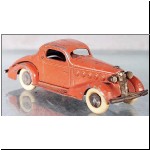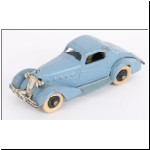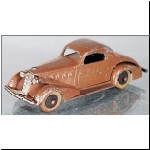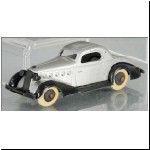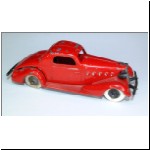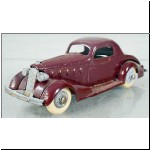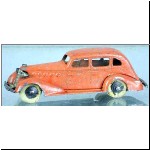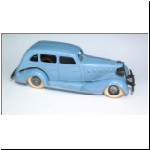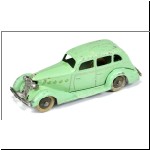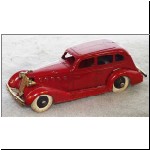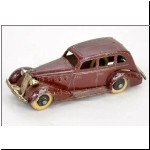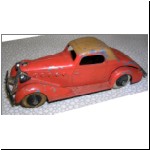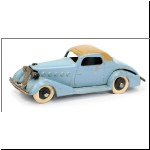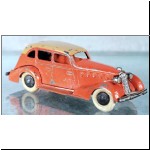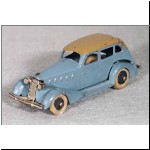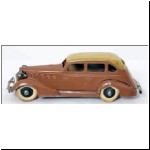|
A History of Pre-War Automotive
Tootsietoys
by Clint Seeley edited by Robert Newson Part 6 - La Salles, Doodlebug and others 1935-37 Clint Seeley's original text is in green, and my editorial additions are in blue. Put your mouse over the thumbnail images to see the picture caption, and click on the thumbnail to enlarge. Last month we covered the vintage year of 1933. 1934 was a year of developmental dormancy at Dowst, perhaps in deference to the new developments hatching out on far-away Binns Road, Liverpool (Clint is referring to the introduction of Dinky toys in 1934). More likely, it was a breather after the extraordinary year that preceded it. The 1934, 1935 and 1936 catalogue covers: 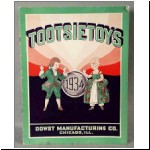 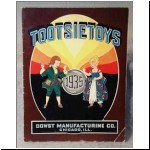 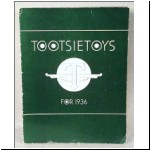 The Tootsietoy
La Salle
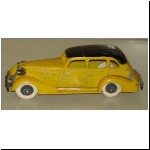 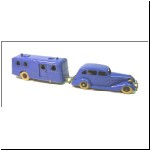 If
1935 was not a
"great" year, it was surely a "good" year, the
vineyards producing perhaps more bouquet than body, but an historic
vintage, nevertheless. The hits of the year were the La Salles
and
the Doodlebug. La Salle
was a General Motors brand of cars, manufactured by Cadillac but at a
slightly lower price and specification. The Tootsietoy La Salles are
beautiful castings and elegant
reproductions of this semi-prestlge car. The body and chassis
parts were engaged by a slightly different method from the Grahams, the
front axle being the only lock (see
the patent details in part 4).
lf any criticism of them is
permissable, it might be the slight gap in the fit between the two
parts over the rear mudguards. There were sedan and coupe
versions, with tan tops again having separate catalogue numbers as
"convertibles''. I have seen these only with the rest of the body
and the chassis having a single colour. Non-convertible versions
sometimes had contrasting body and chassis colouring of a silver body
and black fenders and
chassis. The yellow sedan
illustrated with black roof (a Taxi version?) has been the subject of
some debate, but enough examples have been seen to say that it is
original (information and photo from Larry
Seiber). The medium blue sedan with matching Tootsietoy Roamer
caravan is also original, and was possibly a colour trial for the
Roamer set, which was eventually issued with a Lincoln Zephyr rather
than the La Salle (see below). If
1935 was not a
"great" year, it was surely a "good" year, the
vineyards producing perhaps more bouquet than body, but an historic
vintage, nevertheless. The hits of the year were the La Salles
and
the Doodlebug. La Salle
was a General Motors brand of cars, manufactured by Cadillac but at a
slightly lower price and specification. The Tootsietoy La Salles are
beautiful castings and elegant
reproductions of this semi-prestlge car. The body and chassis
parts were engaged by a slightly different method from the Grahams, the
front axle being the only lock (see
the patent details in part 4).
lf any criticism of them is
permissable, it might be the slight gap in the fit between the two
parts over the rear mudguards. There were sedan and coupe
versions, with tan tops again having separate catalogue numbers as
"convertibles''. I have seen these only with the rest of the body
and the chassis having a single colour. Non-convertible versions
sometimes had contrasting body and chassis colouring of a silver body
and black fenders and
chassis. The yellow sedan
illustrated with black roof (a Taxi version?) has been the subject of
some debate, but enough examples have been seen to say that it is
original (information and photo from Larry
Seiber). The medium blue sedan with matching Tootsietoy Roamer
caravan is also original, and was possibly a colour trial for the
Roamer set, which was eventually issued with a Lincoln Zephyr rather
than the La Salle (see below).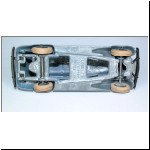 The
wheels were affixed by driving a sharpened axle nail
into a blind hub, rather than by flattening the protruding tip. Conventional axle pins with a crimped
end were also used on later models, as seen on the blue La Salle
sedan and red coupe illustrated. The La Salle was also notable in
being the first Tootsietoy with the name of the real car cast
underneath. By the way, if you run across a La Salle
with a spare wheel, it is either a fraud or hallucination. The
wheels were affixed by driving a sharpened axle nail
into a blind hub, rather than by flattening the protruding tip. Conventional axle pins with a crimped
end were also used on later models, as seen on the blue La Salle
sedan and red coupe illustrated. The La Salle was also notable in
being the first Tootsietoy with the name of the real car cast
underneath. By the way, if you run across a La Salle
with a spare wheel, it is either a fraud or hallucination.The convertible La Salles were in the catalogue for 1935 and 1936 only, while the regular versions lasted two more years. Four gift sets including the La Salles were shown in part 5, i.e. no.0530X 'Tootsietoy De Luxe Motors' (1935), no.05050 'Playtime Toys' (1935-37), no.05075 'Playtime Toys' (1935-36) and no.05200 'Tootsietoy Motor Cars' (1936-38). 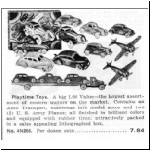 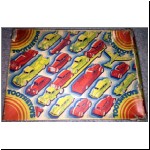  Another large $1 set (like no.05200),
was
no.5500 'Playtime Toys', issued 1937 only, and in my opinion it was a
much more attractive set, without any ugly Jumbo models. The set
included one
each of the La Salle sedan and coupe, along with a Mack Auto
Transport, two Lincoln Zephyr sedans (without motors) and other items
(see photos left). The catalogue illustration is from
the N.Shure Co.
catalogue for 1937, and shows one Lincoln sedan and one Lincoln wrecker
in the set rather than two sedans. Another large $1 set (like no.05200),
was
no.5500 'Playtime Toys', issued 1937 only, and in my opinion it was a
much more attractive set, without any ugly Jumbo models. The set
included one
each of the La Salle sedan and coupe, along with a Mack Auto
Transport, two Lincoln Zephyr sedans (without motors) and other items
(see photos left). The catalogue illustration is from
the N.Shure Co.
catalogue for 1937, and shows one Lincoln sedan and one Lincoln wrecker
in the set rather than two sedans.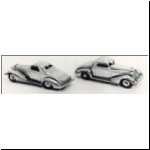 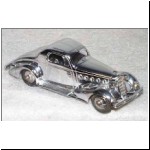  These two chromed
La Salle coupes in the factory collection (leftmost photo) were said to
be from a special
run made for promotional use by the La Salle division of General Motors
Corporation. These two chromed
La Salle coupes in the factory collection (leftmost photo) were said to
be from a special
run made for promotional use by the La Salle division of General Motors
Corporation.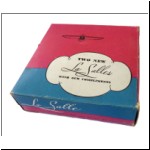 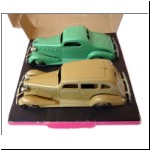 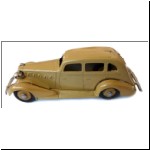 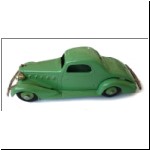  These photos show two La Salles in a very rare General Motors dealer promotional set (courtesy of Philippe de Lespinay). The models are recognisable by wheels painted in body colour and black tyres (information from Larry Seiber). They also have Bild-a-Car axles, and lack the patent number information cast under the bonnet. Doodlebug
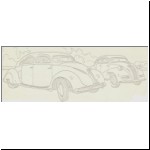 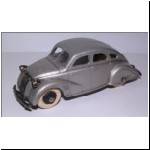   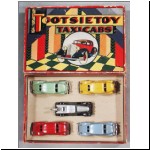 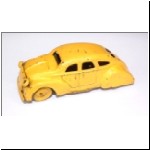 The
Doodlebug is of
special historical interest, and I
had been
planning to write a separate illustrated piece on the subject. It
is quite a faithful reproductlon of a hand-made car designed by John
Tjaarda and built by the Briggs Manufacturing Company for the
Ford-Lincoln organisation. It was shown on "The Ford Exhibition
of Progress", a tour throughout the country in 1934, and is now
generally called the second Briggs prototype (the first prototype
having been a rear engined job which influenced Ferdinand Porsche's
original Volkswagen design). The only real lapse from accuracy of
the Doodlebug was that the Briggs car had the right side of a four-door
sedan while the driver's side had the broad single door and wide
quarter window of a two-door sedan; the
Tootsietoy Doodlebug was a straight four-door version, which never
really existed. The Briggs jobs were experimental forerunners of
what eventually evolved as the Lincoln Zephyr, but the Tjaarda designs
were carefully destroyed and all Ford records of them expunged, because
of the designer's role in the sensational new Chrysler Airflow.
Photographs and data on the car survive in newspaper and other
archives, but don't bother to ask the Ford Museum at Dearborn. The
Doodlebug is of
special historical interest, and I
had been
planning to write a separate illustrated piece on the subject. It
is quite a faithful reproductlon of a hand-made car designed by John
Tjaarda and built by the Briggs Manufacturing Company for the
Ford-Lincoln organisation. It was shown on "The Ford Exhibition
of Progress", a tour throughout the country in 1934, and is now
generally called the second Briggs prototype (the first prototype
having been a rear engined job which influenced Ferdinand Porsche's
original Volkswagen design). The only real lapse from accuracy of
the Doodlebug was that the Briggs car had the right side of a four-door
sedan while the driver's side had the broad single door and wide
quarter window of a two-door sedan; the
Tootsietoy Doodlebug was a straight four-door version, which never
really existed. The Briggs jobs were experimental forerunners of
what eventually evolved as the Lincoln Zephyr, but the Tjaarda designs
were carefully destroyed and all Ford records of them expunged, because
of the designer's role in the sensational new Chrysler Airflow.
Photographs and data on the car survive in newspaper and other
archives, but don't bother to ask the Ford Museum at Dearborn.Thus, the Dowst firm appears to have been caught with a sizeable tooling investment in what might have been another toy "scoop", as the 1928 Model A Ford had been; but instead found that they had to sell a beautiful model of an obscure nothing. They went ahead anyway, christening it the "Doodlebug", hoping to salvage something from the disaster. The Doodlebug, with separate plated pieces for the grllle/headlamps/front bumper and rear bumper/tail lights, may have been manufactured during one or two years, but stayed in the catalogue through 1938 (it is in the UK 1938 leaflet - see part 7 of this article) to clear the inventory. The last photo above is a Japanese tinplate model, obviously a direct copy of the Doodlebug. It has FOREIGN stamped under the tin chassis, and can be found with or without a clockwork motor.   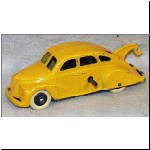 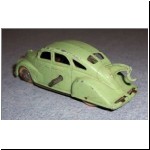 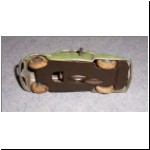 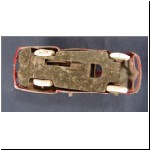 The Doodlebug
was followed (or
joined?)
in 1937 by what they called the Lincoln Zephyr in the Tootsietoy
catalogue, but it was merely the old Doodlebug body die reworked by
modifying the grille to a Lincoln Zephyr form and casting bumpers and a
large rear central tail-light integrally. A version with a boom
and hook in place of the rear light was listed merely as
"wrecker". These were
catalogued in 1937 and 1938 as "Motorized", and were equipped
with Japanese made
key-wound spring motors which never worked and were dropped when the
supply was exhausted.
Non-motorised versions were also made for inclusion in gift sets, for
example set no.5500 shown further up the page, and others in part 5. The Doodlebug
was followed (or
joined?)
in 1937 by what they called the Lincoln Zephyr in the Tootsietoy
catalogue, but it was merely the old Doodlebug body die reworked by
modifying the grille to a Lincoln Zephyr form and casting bumpers and a
large rear central tail-light integrally. A version with a boom
and hook in place of the rear light was listed merely as
"wrecker". These were
catalogued in 1937 and 1938 as "Motorized", and were equipped
with Japanese made
key-wound spring motors which never worked and were dropped when the
supply was exhausted.
Non-motorised versions were also made for inclusion in gift sets, for
example set no.5500 shown further up the page, and others in part 5.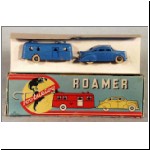 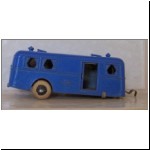  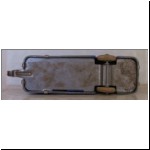  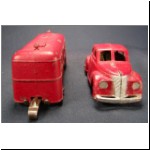  A
large house trailer
(caravan) with steel baseplate and sliding door
was introduced in 1937 (no.1044),
designed to be pulled by the La Salles, one of which was pictured with it in
the 1937
catalogue.
The broad hook had a way of prying the rear bumper off, and a
spring-wound Lincoln was modified to pull the trailer in 1938 (by replacing the central bumper
support with two, one either side of the hook); this
pair was sold in a boxed set as "Tootsietoy Roamer", the name cast in
the side of the trailer, and
the model was no longer sold individually. The same set
was sold in 1939 without
the motor. A
large house trailer
(caravan) with steel baseplate and sliding door
was introduced in 1937 (no.1044),
designed to be pulled by the La Salles, one of which was pictured with it in
the 1937
catalogue.
The broad hook had a way of prying the rear bumper off, and a
spring-wound Lincoln was modified to pull the trailer in 1938 (by replacing the central bumper
support with two, one either side of the hook); this
pair was sold in a boxed set as "Tootsietoy Roamer", the name cast in
the side of the trailer, and
the model was no longer sold individually. The same set
was sold in 1939 without
the motor.The 1934 and
1935 Fords
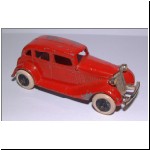   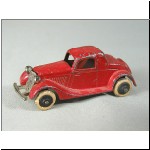  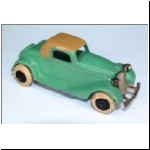 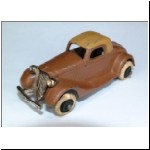 1935
also saw the
entry of the small Fords, allowing for the debut of
the new series Mack transporter, though the older open Mack transporter
carrying four small 1930 Buicks stayed in the catalogue through 1936
(the three-Buick version being last seen in the 1933 catalogue).
The 1934 Fords, having a separate plated radiator/headlamp/bumper piece
resembling a small Graham grille piece, and being fitted with small
rubber-tyred metal hubs, lasted only one year before being replaced by
the one-piece 1935 Fords. The catalogue showed an open 1934
roadster in 1935, but it is not certain whether this was ever made; the
only one ever seen hereabouts was the result of plastic surgery (a
Willard Ford to match the Prosser Dolomite). (Clint is referring to the Dinky Toy
Triumph Dolomite, announced as no.38e but never issued. British
collector Reg Prosser had created an example of how this model might
have been, chopped from a Dinky 40a Riley, and later he wrote an
article describing how the chop was done (ref.11).
Gates
Willard must have done the same for a 1934 Ford Roadster). Coupe
and sedan were catalogued in closed and "convertible" versions,
differing only in paint as with the Grahams and LaSalles. 1935
also saw the
entry of the small Fords, allowing for the debut of
the new series Mack transporter, though the older open Mack transporter
carrying four small 1930 Buicks stayed in the catalogue through 1936
(the three-Buick version being last seen in the 1933 catalogue).
The 1934 Fords, having a separate plated radiator/headlamp/bumper piece
resembling a small Graham grille piece, and being fitted with small
rubber-tyred metal hubs, lasted only one year before being replaced by
the one-piece 1935 Fords. The catalogue showed an open 1934
roadster in 1935, but it is not certain whether this was ever made; the
only one ever seen hereabouts was the result of plastic surgery (a
Willard Ford to match the Prosser Dolomite). (Clint is referring to the Dinky Toy
Triumph Dolomite, announced as no.38e but never issued. British
collector Reg Prosser had created an example of how this model might
have been, chopped from a Dinky 40a Riley, and later he wrote an
article describing how the chop was done (ref.11).
Gates
Willard must have done the same for a 1934 Ford Roadster). Coupe
and sedan were catalogued in closed and "convertible" versions,
differing only in paint as with the Grahams and LaSalles.   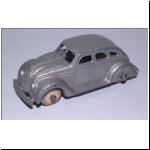 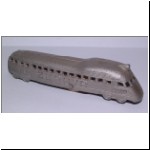 A breakdown truck (wrecker) rounded out the Fords, and a DeSoto Airflow and "Zephyr" railcar completed the small series for the year. 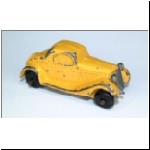  These two photos show a contemporary Danish lead slush-cast copy of the 1934 Ford, shown in Danske Modelbiler (ref.17) as made by Micro of Copenhagen; however the separate grille is not typical of Micro and the toy may be by another manufacturer. The example in the book has metal hubs with rubber tyres, while this one has solid black rubber wheels.  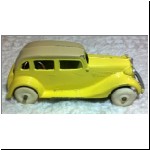 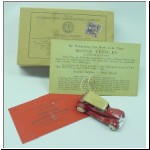   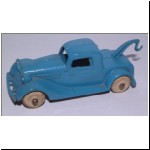  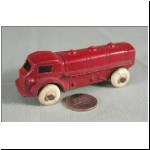 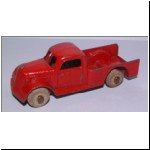 1936 saw the one-piece 1935 Fords replace the 1934 models. The grille and side louvres were altered to conform quite accurately to the newer Ford. The wheels also changed to solid white rubber mounted directly on the axles. The open roadster probably made its real debut, and the line was joined by a Ford pick-up truck. This latter had the truck-type grille rather than the style on the wrecker and passenger cars. A small cab-over oil tanker was also added, differing from the later 235 tanker in being a bit more complicated casting and having an open-sided rear chassis without fender skirts. 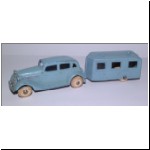 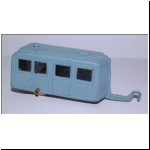  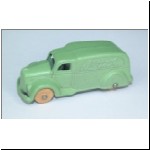 The small Ford series was augmented in 1937 by a small house trailer with a cast tow-bar that reached under the rear of the cars to engage the axle. This was called "camping trailer". Also added to the range was a camel-back delivery van with a still later Ford grille than the pick-up. The standard version had "Special Delivery" cast in script on the side panels, but this van was also issued in a number of private liveries, as the Federal trucks had been more than a decade earlier. Two of the vans had a lithographed tinplate insert bearing the store name tabbed into the side panels, whereas the others had decal transfers. 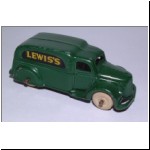    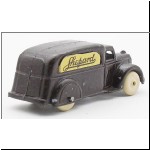 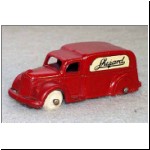 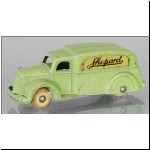 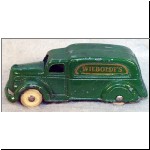 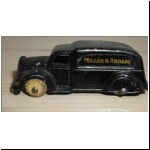 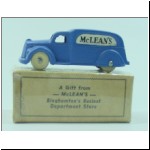 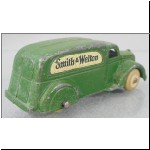 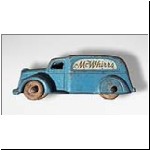 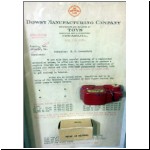 Reproduced here is a fascinating
letter showing how the promotional vans were marketed to department
stores. The letter is dated July 28th 1938, and two sample vans
were attached, one of which (a "Shepard" van) remains in place.
The missing sample was probably a van with decals, as the prices quoted
were slightly cheaper than for the Shepard style of van with tinplate
inserts. As with the earlier special Federal vans (see Part 2), the minimum quantity was 5,000. Reproduced here is a fascinating
letter showing how the promotional vans were marketed to department
stores. The letter is dated July 28th 1938, and two sample vans
were attached, one of which (a "Shepard" van) remains in place.
The missing sample was probably a van with decals, as the prices quoted
were slightly cheaper than for the Shepard style of van with tinplate
inserts. As with the earlier special Federal vans (see Part 2), the minimum quantity was 5,000.
Jumbo Series 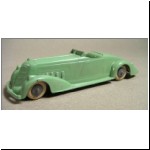  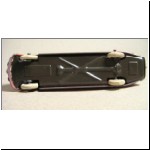   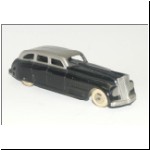   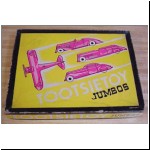 The "Jumbo" series was another 1936 introductlon, later to be called "Torpedo" series. These were six inches long and rather simpler castings than their smaller brethren. Perhaps least ugly of the set was the pick-up truck, having lines similar to the small 1935 Ford. The open roadster of the set had a tapered rear deck vaguely reminiscent of the boat-tailed Auburn Speedster, and is frequently referred to as such by collectors, though never by the maker in catalogues. The other two items released in the series were a sedan and coupe, both rather futuristic and unattractive. Early versions of these two had tin baseplates. A wrecker was added to the series in 1938. 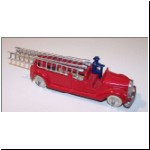 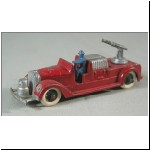 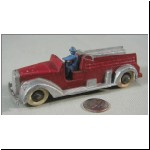  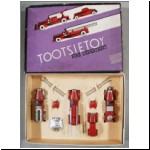  Another
entry in 1937
was a fire engine set having Graham-type wheels
and tyres and a permanently mounted flreman-drlver. This rather
nice set consisted of a hook-and-ladder carrying three interlocklng
ladders, a hose car with water cannon and large front-mounted pump, and
an "insurance patrol" with a simple open rear resembling a chemical
wagon. Two years later this was modified to have a flat deck
carrying a single short ladder which was held in place at the rear by a
standing fireman. This same upright servant was fitted to the
hose wagon by turning the swivelling water cannon forward and making a
raised rear platform such that the figure stood with his T-shaped claw
holding the rear of the gun. In 1938 boxed sets, a red 1935 Ford
coupe was included as a chief's car (although the one pictured above has
a Ford Sedan), but this was replaced from 1939
through 1941 by the open roadster occupied by the seated
fireman-driver. This last little tidbit is hellishly hard to find
today. The bodies were red and silver; the men and ladders were
blue on earlier types and gold after 1939. Another
entry in 1937
was a fire engine set having Graham-type wheels
and tyres and a permanently mounted flreman-drlver. This rather
nice set consisted of a hook-and-ladder carrying three interlocklng
ladders, a hose car with water cannon and large front-mounted pump, and
an "insurance patrol" with a simple open rear resembling a chemical
wagon. Two years later this was modified to have a flat deck
carrying a single short ladder which was held in place at the rear by a
standing fireman. This same upright servant was fitted to the
hose wagon by turning the swivelling water cannon forward and making a
raised rear platform such that the figure stood with his T-shaped claw
holding the rear of the gun. In 1938 boxed sets, a red 1935 Ford
coupe was included as a chief's car (although the one pictured above has
a Ford Sedan), but this was replaced from 1939
through 1941 by the open roadster occupied by the seated
fireman-driver. This last little tidbit is hellishly hard to find
today. The bodies were red and silver; the men and ladders were
blue on earlier types and gold after 1939.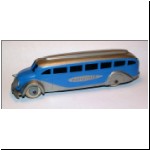 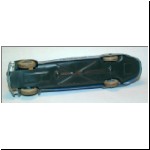 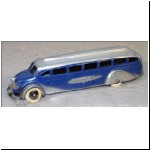  1937 was rounded out by the Greyhound Bus. The single colour version was numbered 1026, and the blue and silver version was 1045. The 1938 UK leaflet (see part 7 of this article) shows both models - 1026 was packed with the Jumbo series in one dozen assortments (presumably two each of six different items), and 1045 was packed in dozens on its own. Originally, it was fitted with a tin base-plate and had larger-than-Graham wheels and tyres, the metal hubs being hollow on the inside. Later, the base-plate was dropped and solid white rubber wheels with chromed hub discs were used. During the war, the casting was modified to have front fender skirts and external axle mounts and was fitted with wooden wheels. After the war, black rubber wheels were mounted by means of axle pins driven into a centre die-cast sleeve. This sequence was also followed by other larger models to survive the war, including the Torpedo series, and others to be covered next month. References (11) "Chop Chop" in Modellers' World magazine, Vol.1 no.2, January 1972. (12) Modellers' World magazine, Vol.9 no.3, April 1980. (17) Danske Modelbiler [Danish Model Cars] by Dorte Johansen & Hans Hedegard, Samler Borsen, 2002 (Danish text). |
© Robert Newson
